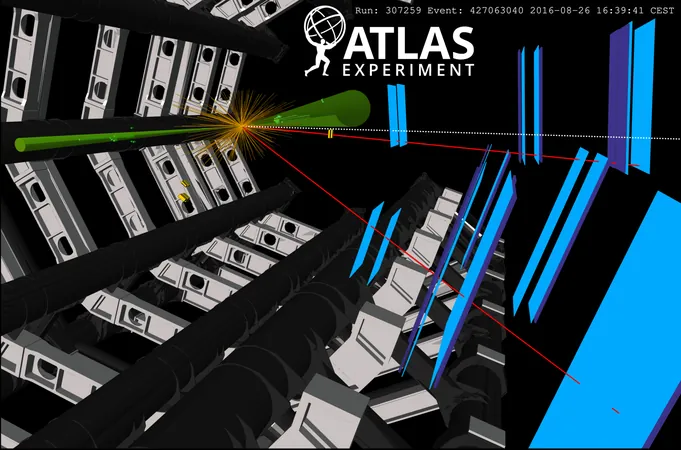
Unveiling the Mysteries of the Higgs Boson: Groundbreaking New Insights!
2025-05-16
Author: Arjun
A Leap Forward in Higgs Boson Research
Since its groundbreaking discovery in 2012, the Higgs boson has captivated physicists eager to unravel its secrets. The ATLAS Collaboration has made exciting progress with the release of three new results, shedding light on how this elusive particle decays into pairs of W and Z bosons, enhancing our grasp of the Standard Model and potentially revealing surprises beyond it.
Precision Measurements Like Never Before
By utilizing the comprehensive dataset from LHC Run 2 (2015-2018) and early Run 3 data (2022-2023), ATLAS physicists made significant progress in measuring Higgs boson decays. Their findings offered new insights into the particle's total width—a critical parameter linked to its fleeting lifetime—while searching for tantalizing signs of new physics phenomena at extreme energy levels.
Breaking Down Complex Results with Simplified Measurements
One of the ongoing quests in Higgs research is to determine how frequently and under what conditions the Higgs boson is produced. To clarify this picture, ATLAS physicists organized their results into 'simplified template cross section' (STXS) regions. This approach allows scientists to analyze production characteristics separately from decay outcomes.
In a groundbreaking new result, scientists delved into STXS measurements of the Higgs boson decaying into two W bosons, which subsequently transform into two leptons (like electrons or muons) along with two neutrinos. Unlike prior research that exclusively considered one electron and one muon, this time ATLAS tackled the challenging same-flavor lepton pairs (two electrons or two muons) to enhance precision significantly—by 20% in areas sensitive to new phenomena.
Challenging the Status Quo: Exploring CP Symmetry
Fascinatingly, ATLAS researchers utilized the STXS framework to test for charge-parity (CP) symmetry violation, a significant question that the Standard Model doesn't fully address. This groundbreaking measurement reveals potential gaps in understanding the matter-antimatter asymmetry that shapes our universe.
Unlocking the Secrets of Higgs Width with Off-Shell Studies
In quantum physics, particles can deviate from their expected mass, a phenomenon known as off-shell production. This effect is pivotal for understanding the Higgs boson's width, closely linked to its fleeting lifetime of a mere 10^(-22) seconds. With a predicted width of just 4.1 MeV, direct measurements remain elusive, making off-shell research essential.
Earlier measurements leveraging Higgs decays to Z-boson pairs paved the way, but using W-boson decays posed increased complexity due to neutrinos escaping detection. ATLAS researchers ingeniously utilized quantum interference effects to reveal subtle signals from off-shell Higgs production.
Exploring New Heights: Higgs Studies at 13.6 TeV
The pursuit of knowledge continues with exciting new studies at 13.6 TeV using Run 3 data, offering unprecedented opportunities to understand the Higgs boson at higher energies. Recent differential cross-section analyses explore production mechanisms, scrutinizing their results against theoretical predictions to spot signs of groundbreaking new physics.
By integrating findings from both Run 2 and Run 3 data, ATLAS has tightened limits on the Higgs boson's couplings, marking a pivotal advancement in precision measurements at the LHC.
The Horizon of Physics Awaits!
With each new discovery, we inch closer to understanding the very fabric of our universe. The recent findings from the ATLAS Collaboration not only illuminate the behavior of the Higgs boson but could also open doors to answering profound questions that have long puzzled physicists. Stay tuned as the mysteries of particle physics continue to unfold!



 Brasil (PT)
Brasil (PT)
 Canada (EN)
Canada (EN)
 Chile (ES)
Chile (ES)
 Česko (CS)
Česko (CS)
 대한민국 (KO)
대한민국 (KO)
 España (ES)
España (ES)
 France (FR)
France (FR)
 Hong Kong (EN)
Hong Kong (EN)
 Italia (IT)
Italia (IT)
 日本 (JA)
日本 (JA)
 Magyarország (HU)
Magyarország (HU)
 Norge (NO)
Norge (NO)
 Polska (PL)
Polska (PL)
 Schweiz (DE)
Schweiz (DE)
 Singapore (EN)
Singapore (EN)
 Sverige (SV)
Sverige (SV)
 Suomi (FI)
Suomi (FI)
 Türkiye (TR)
Türkiye (TR)
 الإمارات العربية المتحدة (AR)
الإمارات العربية المتحدة (AR)